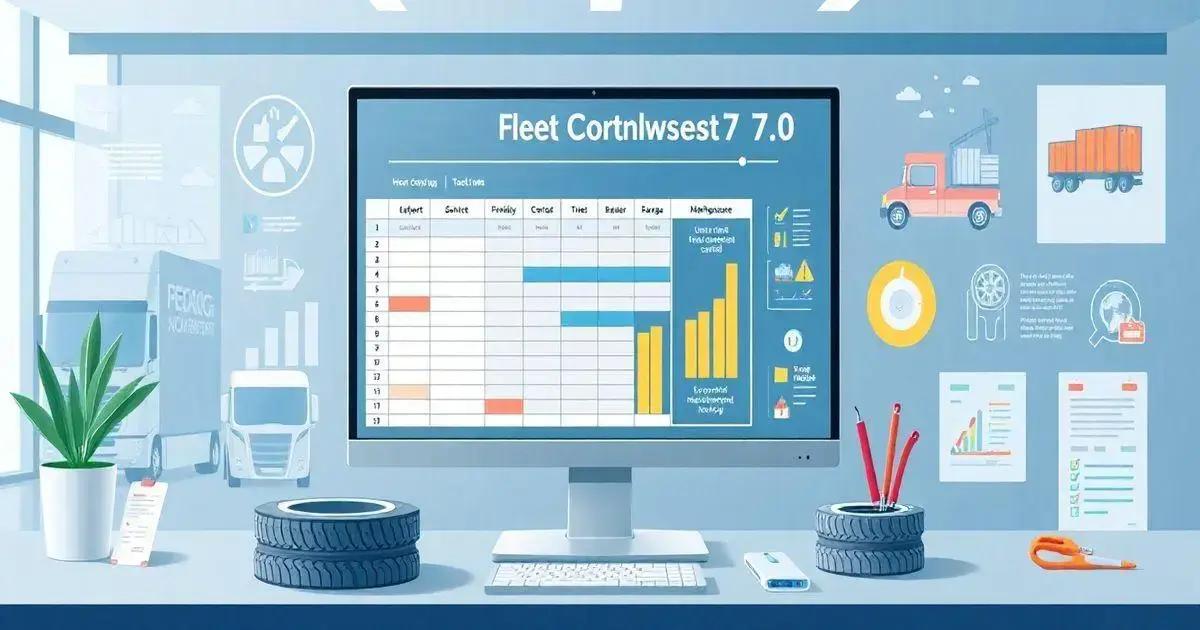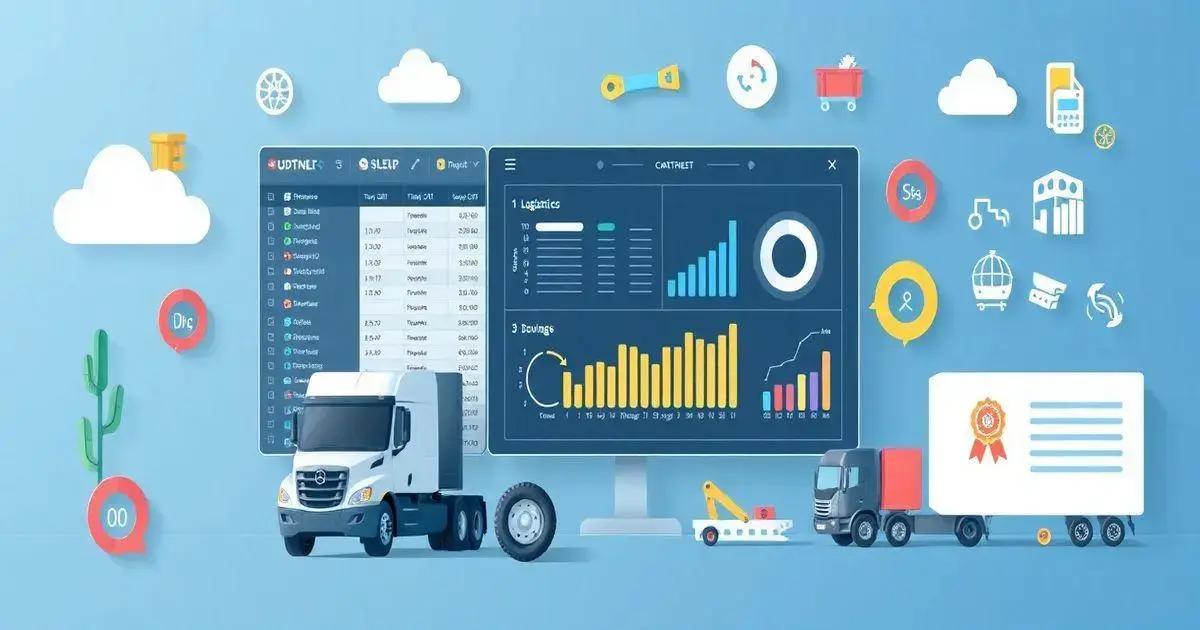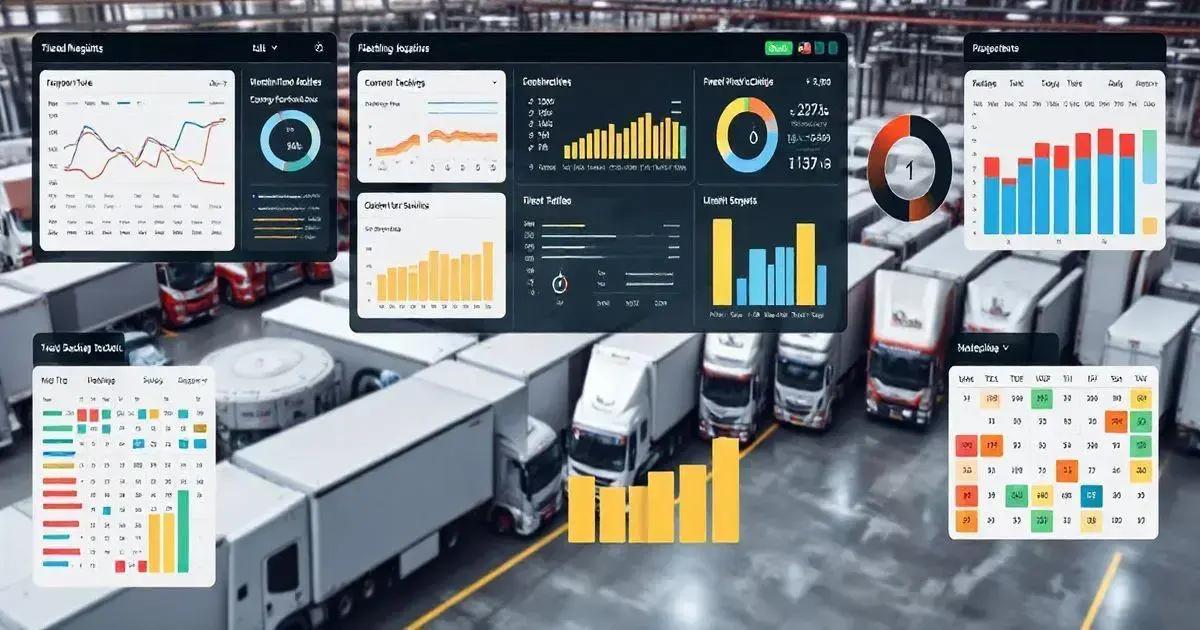Unlock Fleet Management: Fleet Control Worksheet 7.0 Leave a comment
The Fleet Control Worksheet 7.0 is a comprehensive fleet management tool that provides features for tracking performance metrics, managing documentation, controlling travel and maintenance, and ensuring tire safety, enabling fleet managers to optimize operations and reduce costs effectively.
The Fleet Control Worksheet 7.0 is an essential tool for businesses looking to streamline their fleet management processes. This powerful spreadsheet offers features like travel and cargo control, tire management, and comprehensive maintenance tracking, making it a vital resource for anyone in logistics or operational management.
Initial Dashboards Overview
The Initial Dashboards in the Fleet Control Worksheet 7.0 provide a comprehensive overview of key performance indicators that help fleet managers make informed decisions. This dashboard is designed to display crucial data at a glance, ensuring that users can monitor fleet operations efficiently.
Key Metrics Featured:
- KM by Driver: Tracks the total kilometers driven by each driver, allowing for performance assessments and identifying top performers.
- KM per Vehicle: This metric evaluates how much distance each vehicle covers, providing insights into vehicle utilization.
- KM per Liter: Monitors fuel efficiency by calculating kilometers driven for every liter of fuel consumed.
- KM per Trip: Analyzes the average kilometers covered in each trip, assisting in route optimization and planning.
- Average Consumption per Vehicle: Provides a clear view of fuel consumption patterns across different vehicles.
- Average Consumption per Driver: Helps in assessing which drivers are more fuel-efficient and may require training for others.
- Total General Maintenance: Displays total maintenance efforts for the fleet, both preventive and corrective, ensuring all vehicles are well-maintained.
- Maintenance Cost Average: Calculates the average costs associated with maintenance, which is vital for budgeting.
- Total Mechanical and Electrical Maintenance Costs: Tracks the overall maintenance costs of mechanical and electrical issues, allowing for better financial planning.
- Total Tire Maintenance Cost: This section provides insights into how much is being spent on tire management, which is crucial for operational efficiency.
- Total Lubricant Cost: Keeps track of lubricant expenses which can significantly impact vehicle performance.
- Average Maintenance Costs: This calculates the average costs incurred during maintenance, giving a clear picture of maintenance efficiency.
- Vehicles in Transit: Displays the total number of vehicles currently on the road, which aids in scheduling and logistics management.
- Tires in Transit: Similar to vehicles, this tracks the number of tires that are currently being used, useful for inventory management.
- Delayed Vehicle Documents: Helps monitor vehicles with unresolved documentation issues, assisting in compliance management.
- Delayed Driver Documents: Tracks any outstanding documentation for drivers, ensuring all personnel are compliant with legal requirements.
- Delayed Preventive Maintenance: Alerts managers to scheduled maintenance that has been delayed, promoting proactive management.
- Total Cost Versus Shipping: This metric compares the overall costs incurred against shipping revenues, allowing for profitability analyses.
- Fuel, Maintenance, and Other Costs: Provides a breakdown of all related costs, offering a holistic view of fleet operation expenses.
By utilizing these metrics, fleet managers can optimize their operations, reduce costs, and improve overall efficiency in fleet management. The Fleet Control Worksheet 7.0 is not just a tool; it’s an essential part of a successful logistics strategy.

Registration Requirements for Drivers and Vehicles
The Registration Requirements for Drivers and Vehicles section of the Fleet Control Worksheet 7.0 is essential for maintaining accurate records and ensuring compliance within your fleet management system. This portion of the worksheet outlines the necessary information needed for both drivers and vehicles to operate efficiently and legally.
Driver Registration:
- Driver Name: Full name of the driver, which is crucial for identification and record-keeping.
- Driver License Number: A unique identifier for the driver that confirms they are legally allowed to operate vehicles.
- Contact Information: Essential details such as phone number and email address which are important for communication regarding schedules, emergencies, and updates.
- Training Certificates: Documentation proving that the driver has completed necessary training for the specific vehicles they will operate, ensuring safety and compliance.
- Medical Examination Records: Proof that the driver has passed a medical check-up, confirming they are fit to drive.
- Experience and Qualifications: A record of the driver’s previous experience and qualifications, aiding in ensuring they are appropriately qualified for their role.
Vehicle Registration:
- Vehicle Identification Number (VIN): A unique code used to identify individual motor vehicles, crucial for legal registration and tracking.
- Make and Model: Essential details about the vehicle type which can assist in maintenance tracking and recall management.
- Year of Manufacture: Important for assessing vehicle age, depreciation, and maintenance schedule.
- Registration Date: The date when the vehicle was registered, important for compliance and renewal tracking.
- Insurance Information: Details regarding the vehicle’s insurance policy, which is necessary for legal operation and risk management.
- Current Mileage: Keeping track of the vehicle’s mileage is important for maintenance schedules and assessing vehicle performance.
- Maintenance History: A record of all services and repairs performed on the vehicle, which aids in evaluating reliability and planning future maintenance.
By diligently collecting and maintaining this information, fleet managers can ensure that their operations comply with legal regulations and that their drivers and vehicles are prepared for safe and efficient performance on the road. The Fleet Control Worksheet 7.0 simplifies this process by providing structured sections for inputting and tracking these critical registration details.
Document Management Features
The Document Management Features section of the Fleet Control Worksheet 7.0 is designed to streamline the organization and monitoring of essential documentation related to both drivers and vehicles. Effective document management is crucial for compliance, safety, and operational efficiency within fleet management.
Key Components of Document Management:
Key Components of Document Management:
- Driver Document Control: This feature allows for the systematic tracking of all documents associated with each driver, including:
- License Expiration Dates: Alerts for upcoming renewals to ensure drivers remain compliant.
- Training Certificates: Records the completion of necessary training and certifications, ensuring drivers are qualified to operate specific vehicles.
- Medical Records: Keeps track of the driver’s medical examination results and any health-related documentation.
- Vehicle Document Control: Similar to driver documents, this feature aids in maintaining comprehensive records for each vehicle, such as:
- Registration Papers: Keeps copies of vehicle registration documents for legal compliance.
- Insurance Policies: Tracks insurance validity and renewal dates, ensuring all vehicles are adequately covered.
- Maintenance Records: Documents all service and repair work done on the vehicle, which is vital for assessing performance and longevity.
- Inspection Certificates: Stores records of periodic inspections to ensure vehicles meet safety standards.
- Automated Reminders: The document management system is equipped with automated reminders for important dates, such as:
- License renewals for drivers.
- Insurance expiration dates for vehicles.
- Scheduled vehicle inspections and maintenance.
- Centralized Access: All documents can be accessed from a centralized location within the worksheet, making it easy for fleet managers to retrieve necessary information quickly.
- Audit Trail: Maintains a history of document updates and changes, providing accountability and transparency in document management.
By implementing these document management features, the Fleet Control Worksheet 7.0 not only helps ensure compliance with regulatory requirements but also enhances operational efficiency by reducing the risks associated with lost or expired documents. This structured approach to document management is essential for maintaining a successful and compliant fleet operation.

Travel Control Mechanisms
The Travel Control Mechanisms section of the Fleet Control Worksheet 7.0 is instrumental in managing and monitoring the various aspects of each trip undertaken by your fleet. This feature allows fleet managers to gain valuable insights into travel costs, driver performance, and cargo management, ultimately leading to improved efficiency and reduced expenses.
Essential Features of Travel Control:
- Cargo Control Linked to Trips: This feature ensures that all cargo is tracked and managed effectively throughout its journey. Details include:
- Type of Cargo: Specification of what is being transported, which is crucial for inventory and compliance.
- Weight and Volume: Accurate recording of cargo weight and volume to ensure vehicles are not overloaded and to assist with logistical planning.
- Delivery Schedules: Timelines for when cargo needs to be delivered, helping to optimize routes and reduce delays.
- Vehicle Control: This aspect focuses on monitoring the vehicles used for each trip, including:
- Assignment of Vehicles: Ensures that the right vehicle is allocated based on cargo requirements and driver availability.
- Vehicle Condition Reports: Provides insights into the condition of the vehicle before and after trips, assisting in maintenance planning.
- Fuel Consumption Tracking: Monitors fuel usage during each trip, which is vital for assessing efficiency and managing costs.
- Driver Control: This component tracks driver performance and accountability, featuring:
- Driver Performance Metrics: Evaluation of drivers based on various criteria, such as punctuality, fuel efficiency, and adherence to routes.
- Feedback Mechanisms: A system for gathering feedback from drivers about the trip, including any challenges faced and suggestions for improvement.
- Training Needs Assessment: Identifying areas where drivers may require additional training based on trip performance.
- Supply Control: Manages the supplies needed for each trip, ensuring that all necessary items are accounted for:
- Inventory of Supplies: Keeps track of all supplies required for cargo handling, including packaging and securing materials.
- Pre-Trip Checklist: A checklist to ensure that all supplies are loaded and ready for transport before departure.
- Control of All Travel Expenses: This feature compiles and analyzes all costs associated with each trip, such as:
- Fuel Costs: Detailed tracking of fuel expenses for accuracy in financial reporting.
- Toll Fees: Monitoring of toll charges incurred during the journey to ensure accurate accounting.
- Driver Pay: Calculation of any additional compensation or bonuses based on trip performance and efficiency.
By utilizing these travel control mechanisms, fleet managers can enhance oversight of all trips, ensuring that every aspect is accounted for, from cargo management to driver performance. This integrated approach not only improves operational efficiency but also leads to significant cost savings and better resource allocation.
Tire Control Management
The Tire Control Management feature in the Fleet Control Worksheet 7.0 is crucial for ensuring the safety, performance, and efficiency of your fleet. Proper tire management not only extends the lifespan of tires but also significantly impacts fuel efficiency and overall vehicle handling.
Key Components of Tire Control Management:
- Identification for Each Tire: This component keeps a detailed record of each tire in the fleet, including:
- Tire IDs: Unique identifiers for each tire to track their usage and maintenance history.
- Tire Specifications: Information about the tire size, type, and load rating to ensure proper fit and performance.
- Tire Purchase Dates: Recording when each tire was acquired, which aids in evaluating its lifespan and planning replacements.
- Tire Change Schedule by KM: This feature helps manage tire replacements based on mileage, including:
- Recommended Change Intervals: Guidelines for when tires should be replaced based on kilometers driven, ensuring timely changes to maintain safety.
- Current Mileage Tracking: Continuous monitoring of the current mileage of each tire to assess when it is due for replacement.
- Alerts for Change: Automated notifications to alert fleet managers when tires are approaching their recommended change limits based on mileage.
- Signal of Remaining KM Until Tire Change: This tool provides a clear indication of how much distance can be driven before the tire needs to be replaced:
- Real-Time Calculations: Ongoing computations of remaining kilometers based on current usage and previous data.
- Visual Indicators: Easy-to-read signals or alerts within the worksheet to highlight tires that are nearing their change threshold.
- Status per Action: This feature categorizes tire status based on various actions, including:
- Allocate to Vehicle: Tracking which tires are assigned to which vehicles, improving accountability and management.
- Remove from Vehicle: A record of any tires removed and the reasons for removal, such as wear or damage.
- Scrap: Documenting tires that are no longer usable and need to be disposed of safely.
- Maintenance Checks: Scheduling regular tire maintenance inspections and tracking actions taken to address any issues.
Effective tire control management through the Fleet Control Worksheet 7.0 not only enhances the safety of the fleet but also contributes to operational efficiency and cost savings. By monitoring tire conditions and adhering to recommended change schedules, fleet managers can ensure their vehicles perform optimally and reduce the risk of tire-related incidents on the road.

Maintenance Control and Analysis
The Maintenance Control and Analysis section of the Fleet Control Worksheet 7.0 is designed to ensure that all vehicles in your fleet are maintained properly and efficiently. Regular maintenance is critical for maximizing vehicle lifespan, ensuring safety, and minimizing unexpected breakdowns.
Essential Features of Maintenance Control:
- Corrective and Preventive Maintenance Types: This feature categorizes maintenance into two primary types:
- Preventive Maintenance: Scheduled and routine checks intended to prevent issues before they occur. This includes oil changes, tire rotations, and fluid checks.
- Corrective Maintenance: Repairs performed after a fault or breakdown has occurred, ensuring that vehicles are restored to optimal operating condition.
- Maintenance by Vehicle: This tool allows fleet managers to track maintenance activities specific to each vehicle:
- Individual Maintenance Histories: Comprehensive records of all maintenance performed on each vehicle, which aids in analyzing performance and reliability.
- Scheduled Maintenance Alerts: Automated reminders for upcoming maintenance tasks based on set schedules or vehicle mileage.
- Maintenance by Mechanical and Electrical Type: This feature categorizes maintenance activities based on the nature of the issue:
- Mechanical Maintenance: Tracking repairs related to engine, transmission, and other mechanical components.
- Electrical Maintenance: Logging services performed on electrical systems, such as batteries, wiring, and lighting.
- Tire and Lubricant Maintenance: Special attention to tire conditions and lubrication services to ensure optimal performance.
- Maintenance Cost Tracking: Keeping an eye on the financial aspects of vehicle maintenance:
- Total Maintenance Costs: A comprehensive overview of all expenses associated with maintaining the fleet, helping to create budgets and forecast future spending.
- Average Maintenance Costs: Calculation of average costs per vehicle, providing insights into which vehicles may require more frequent or costly repairs.
- Preventive Maintenance Schedule: This feature outlines a proactive approach to maintenance:
- Regular Scheduling: Setting up a calendar for routine checks, ensuring that each vehicle receives necessary maintenance on time.
- Maintenance History Reports: Generating reports that provide a history of all maintenance performed, which can be used for audits or performance reviews.
- Preventive Maintenance Signals: Keeping track of the status of maintenance tasks:
- Tracking Status: Flags or indicators that show whether maintenance is scheduled, completed, or overdue.
- Action Items: Clear actionable items for fleet managers to address any overdue maintenance tasks promptly.
- Status Tracking: Scheduled, Accomplished, and Delayed: This feature aids in maintaining accountability:
- Scheduled: All tasks that are planned for future maintenance.
- Accomplished: A record of all maintenance that has been completed successfully.
- Delayed: Any maintenance that has not been carried out as scheduled, enabling managers to follow up and prioritize these tasks.
By incorporating thorough maintenance control and analysis within the Fleet Control Worksheet 7.0, fleet managers can significantly enhance the reliability and performance of their vehicles. This systematic approach not only ensures safety but also contributes to strategic decision-making and operational efficiency.
Conclusion
In summary, the Fleet Control Worksheet 7.0 serves as a comprehensive tool for effectively managing all facets of fleet operations. From the meticulous tracking of driver and vehicle registrations to detailed maintenance control and travel management, this worksheet empowers fleet managers to optimize efficiency and reduce costs.
The structured approach to document management, tire control, and maintenance analysis ensures that your fleet remains compliant, safe, and productive. By leveraging these features, businesses can not only enhance operational performance but also nurture a culture of accountability and proactive management.
Implementing the Fleet Control Worksheet 7.0 in your operations will pave the way for smarter decision-making and long-term success in your fleet management strategy. Whether you’re a small business or a large enterprise, this tool is essential for maintaining a competitive edge in today’s dynamic market.
FAQ – Frequently Asked Questions about Fleet Control Worksheet 7.0
What features does the Fleet Control Worksheet 7.0 offer?
The Fleet Control Worksheet 7.0 offers features such as travel control, maintenance tracking, tire management, driver registration, and comprehensive document management.
How can I track maintenance for my vehicles?
You can track maintenance by recording each service performed on the vehicles within the worksheet, including dates, costs, and types of maintenance completed.
Is there a way to manage tire life and usage?
Yes, the worksheet includes tire control management features that allow you to monitor tire identification, usage, change schedules, and maintenance history.
Can I access drivers’ documents using this tool?
Absolutely! The worksheet provides a document management system to track all necessary driver documents, such as licenses and training certificates.
How does the automated alert system work?
The automated alert system notifies you of upcoming maintenance, driver document expirations, and other critical dates, ensuring proactive management.
Is the Fleet Control Worksheet customizable?
Yes, the worksheet can be customized to fit your specific fleet management needs, allowing you to add or modify fields as necessary.

